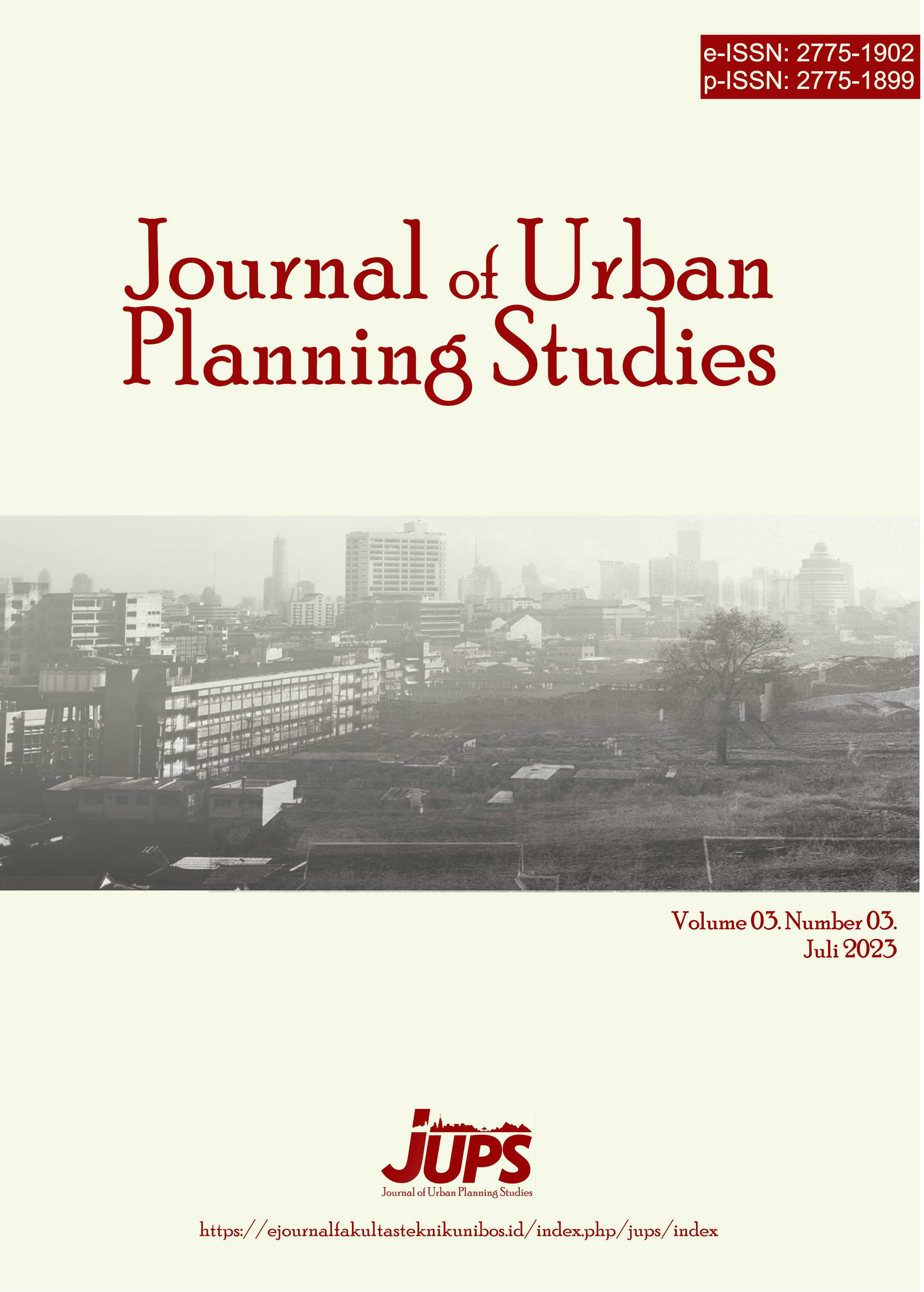Analisis Pengaruh Perubahan Penggunaan Lahan Terhadap Perubahan Suhu Permukaan pada Kawasan Sub Urban Kota Makassar
(Studi Kasus : Kecamatan Biringkanaya dan Kecamatan Tamalanea)
DOI:
https://doi.org/10.35965/jups.v3i3.401Kata Kunci:
GIS, Urban Planning, Land use Change, Urban Heat IslandAbstrak
Abstract. Makassar City is a city that is experiencing growth. With growth, changes in land use that occur in a city indirectly have an impact on increasing surface temperatures. With the development of remote sensing technology, it is now possible to determine the effect of changes in land cover on changes in surface temperature in the city of Makassar. This type of research is quantitative. using satellite imagery interpretation analysis to see changes in land use and LST (Land surface temperature) analysis to measure surface temperature. The results of the study are the Makassar City Sub-Urban Area. There has been a change in land use from 2017 to 2021, namely 4.5% or 339.6 Ha and from 2017 to 2021 there has been a change in surface temperature in the Sub-Urban Area of Makassar City with an average increase of 4.6°C - 5.8°C. Then, based on the results of the simple linear regression test, there is an effect of changes in land use on surface temperature in the moderate category. ah Or other related agencies, in order to reduce the impact of increasing surface temperature due to changes in land use, it is necessary to control changes in land use and the government so that they can refer to this research as material for the Makassar City spatial plan as well as strategies for program planning policies in Makassar City Sub-Urban Area.
Abstrak. Kota Makassar merupakan kota yang mengalami Pertumbuhan. Dengan adanya Pertumbuhan maka perubahan penggunaan lahan yang terjadi dalam suatu kota secara tidak langsung berdampak dengan meningkatnya suhu permukaan Dengan semakin berkembangnya teknologi penginderaan jauh yang saat ini dapat mengetahui pengaruh perubahan tutupan lahan terhadap perubahan suhu permukaan di kota Makassar.Jenis penelitian ini adalah kuantitatif.dengan menggunakan Analisis interpretasi citra satelit Untuk melihat Perubahan Penggunaan Lahan Dan Analisis LST (Land surface Temperature) Untuk Mengukur suhu PermukaanHasil Penelitian ialah Kawasan Sub Urban Kota Makassar Telah terjadi Perubahan penggunaan lahan sejak 2017 hingga 2021 yaitu 4.5% atau 339.6 Ha dan sejak tahun 2017 hingga 2021 telah terjadi perubahan suhu permukaan di Kawasan Sub Urban Kota Makassar dengan rata-rata kenaikan 4.6°C - 5.8°C Kemudian Berdasarkan hasil uji Regresi linear sederhana ada pengaruh perubahan penggunaan lahan terhadap suhu permukaan dengan kategori moderat.Saran Penulis Kepada Pemerintah Ataupun Instansi lain Yang terkait, Guna Mengurangi Dampak dari Peningkatan Suhu Permukaan akibat Perubahan Penggunaan Lahan Ialah Perlu adanya pengendalian terhadap perubahan penggunaan lahan serta pihak pemerintahan agar dapat mengacu pada penelitian ini sebagai bahan untuk rencana tata ruang Kota Makassar serta strategi untuk kebijakan rencana program di Kawasan Sub Urban Kota Makassar.
Referensi
Chin, W. W. (1998). The Partial Least Squares Aproach to Structural Equation Modeling. Modern Methods for Business Research, 295, 336
Iqbal, M dan Sumaryanto. 2007. Strategi Pengendalian Alih Fungsi Lahan Pertanian Bertumpu Pada Partisipasi Masyarakat. Pusat Analisis Sosial Ekonomi dan Kebijakan Pertanian. Bogor: Pusat Analisis Sosial Ekonomi dan Kebijakan Pertanian
Mabry, T.J., Markham, K.R., Thomas, M.B., 1970, The Systematic and Identification of Flavonoid, Hal 3-56, Springer-Verlag, New York, Helderberg-Berlin.
Pradana Putra, M. A., & Jufriadi, J. (2020). Pengaruh Pembangunan Industri Kelapa Terhadap Pemanfaatan Lahan Di Desa Kayutanyo Kecamatan Luwuk Timur Kabupaten Banggai. Journal of Urban Planning Studies, 1(1), 088-097.
Sugiyono. (2011). Metode Penelitian Kuantitatif, Kualitatif dan R&D. Bandung: Alfabeta
Ruslan, R., Yahya, F. A., & Surya, B. (2021). Analisis kemampuan Lahan Kawasan Perkotaan Wawo Kabupaten Kolaka Utara. Journal of Urban Planning Studies, 1(3), 264–281
Karyono. 2013. Forensic Fraud. Yogyakarta: CV. Andi.
Al Mukmin, S. A., Wijaya, A., & Sukmono, A. (2016). Analisis Pengaruh Perubahan Tutupan Lahan Terhadap Distribusi Suhu Permukaan Dan Keterkaitannya Dengan Fenomena Urban Heat Island. Jurnal Geodesi Undip, 5(1), 224–233
Delarizka, Almira. (2016). Analisis Fenomena Pulau Bahang (Urban Heat Island) Di Kota Semarang Berdasarkan Hubungan Antara Perubahan Tutupan 98 Lahan Dengan Suhu Permukaan Menggunakan Citra Multi Temporal Landsat. Semarang : Jurnal Geodesi UNDIP Vol.5, No.4
Sobirin, S., & Fatimah, R. N. (2015). Urban Heat Island Kota Surabaya. Geo Edukasi, 4(2).
##submission.downloads##
Diterbitkan
Cara Mengutip
Terbitan
Bagian
Lisensi
Hak Cipta (c) 2024 Muhammad Taufiq Ramadhan, Rahmawati Rahman, Emil Salim Rasyidi

Artikel ini berlisensi Creative Commons Attribution 4.0 International License.













